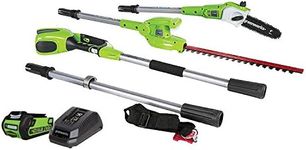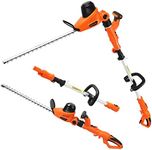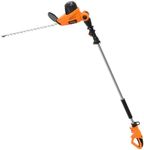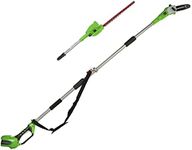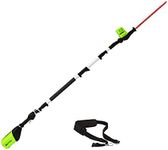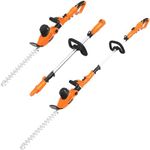Buying Guide for the Best Pole Hedge Trimmers
Choosing the right pole hedge trimmer can make garden maintenance much easier and safer, especially when dealing with tall or wide hedges. The key is to match the tool’s features to your specific needs, such as the height of your hedges, the thickness of the branches, and how often you plan to use the trimmer. Understanding the main specifications will help you select a trimmer that is comfortable, efficient, and safe for your gardening tasks.Power SourcePole hedge trimmers can be powered by electricity (corded), batteries (cordless), or gasoline. The power source affects the tool’s mobility, weight, and maintenance needs. Corded models offer continuous power but require access to an outlet and can be limited by the cord length. Cordless models provide more freedom of movement and are quieter, but their runtime depends on battery capacity. Gasoline models are typically the most powerful and suitable for heavy-duty work, but they are heavier, noisier, and require more maintenance. Choose a power source based on the size of your garden, the distance from power outlets, and your preference for convenience versus power.
Blade LengthBlade length determines how much hedge you can trim in one pass and how easily you can reach across wide hedges. Shorter blades (around 16-18 inches) are easier to control and better for detailed work or smaller hedges. Medium blades (18-22 inches) offer a balance between reach and control, suitable for most home gardens. Longer blades (over 22 inches) can cover more area quickly and are ideal for large or tall hedges, but they can be harder to maneuver. Consider the size and shape of your hedges to decide which blade length will be most effective for you.
Pole Length/ReachThe pole length, or maximum reach, determines how high you can trim without a ladder. Some models have fixed poles, while others are telescopic and can be adjusted. Shorter poles (up to 6 feet) are suitable for low to medium hedges. Medium poles (6-9 feet) can handle most residential needs. Longer poles (over 9 feet) are best for very tall hedges but can be heavier and harder to control. Think about the height of your hedges and whether you want to avoid using ladders to guide your choice.
Cutting CapacityCutting capacity refers to the maximum branch thickness the trimmer can handle, usually measured in millimeters or inches. Smaller capacities (up to 0.5 inches) are fine for light trimming and young hedges. Medium capacities (0.5-0.75 inches) suit most mature hedges. Larger capacities (over 0.75 inches) are needed for thick, woody branches. Assess the type and age of your hedges to ensure the trimmer can handle the branches you need to cut.
WeightThe weight of a pole hedge trimmer affects how long you can use it comfortably, especially when working overhead. Lighter models are easier to handle and reduce fatigue, making them suitable for longer sessions or users with less upper body strength. Heavier models may offer more power but can be tiring to use for extended periods. Consider your physical comfort and the duration of your typical trimming tasks when evaluating weight.
Adjustable Head/AngleSome pole hedge trimmers have adjustable heads that can pivot or tilt, allowing you to trim at different angles. This feature is useful for shaping the tops and sides of hedges or reaching awkward spots. Fixed heads are simpler but less versatile. If your hedges have complex shapes or you want to avoid awkward body positions, an adjustable head can make trimming easier and more precise.




